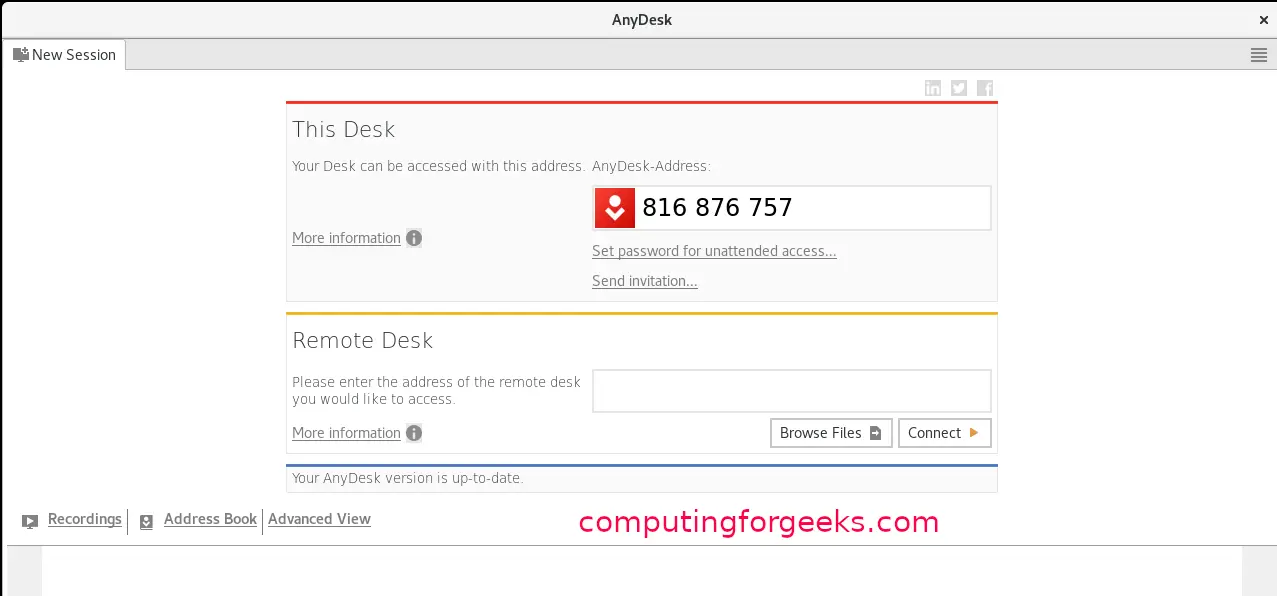This brief tutorial shows students and new users how to install AnyDesk on Ubuntu 20.04 | 18.04 LTS.
AnyDesk is cross-platform, fast, secure and intuitive remote desktop support software.
After downloading the file, go to the /Download folder and right-click the downloaded file then Open With Software Install as shown in the image below When Ubuntu Software app opens, click the Install button to install AnyDesk. Doing this should start the installation.
AnyDesk is not opensource, however, if you’re looking for a strong alternative to support tools like TeamViewer, LogMeIn and others, this tools should be considered.
- Now Install AnyDesk on RHEL 8 or CentOS 8 after the AnyDesk repository has been added to the system. S udo dnf makecache sudo dfn install -y redhat-lsb-core sudo dfn install anydesk. Agree to import the GPG key by selecting ‘y’ from the received terminal prompt. This step will initialize the installation of AnyDesk on RHEL 8 / CentOS 8.
- Apt install aptitude aptitude install debian-archive-keyring aptitude install synaptic apt-xapian-index gdebi 2 Install i3 Install i3 and lightdm sudo apt-get install xorg sudo apt-get install i3 i3status i3lock i3blocks dmenu sudo apt-get install lightdm sudo reboot 3 Install xfce4 apt install xfce4 4 Install clipit apt install clipit.
It’s a great tool for tech support specialists and users who want to provide remote assistance while enjoying secure and high quality experience. It can also be used for meeting and collaboration similar to WebEx and other desktop sharing tools.
Whether as an individual, or as a professional organization offering remote support to customers, AnyDesk is made for easy operation and solid remote connectivity.

There are multiple ways to install AnyDesk on Ubuntu. The easiest way to install AnyDesk is to add its software repository to Ubuntu and install from there.
By default, the software packages are not included with Ubuntu. So you must manually install it or use its repository.

Option 1: Install AnyDesk from Repository
For those who want to quickly and easily install AnyDesk, they can use the commands below;
First, add its software repository’s key to Ubuntu:
Then add its repository file.
Finally, update Ubuntu repository list and install AnyDesk
To launch from the command line, type the commend below:
That should open up and allow you to use the software.
Option 2: Download AnyDesk
For those who are not familiar with the command line in option 1, they can use the desktop GUI to download and install AnyDesk.
Open your browser and browse to the link below. There you’ll want to choose the package built for Debian/Ubuntu/Mint
Then click the Download Now button.
Install Anydesk Debian 10
When prompted what to do with the file, choose to save. This should save into your Downloads folder in your Home directory.
Install Anydesk Debian 10 Buster
After downloading the file, open the File explorer on the left, then go to the Download folder in your Home directory.
Right-click the downloaded file and select Open With Software Install as shown in the image below.
When Ubuntu Software app opens, click the Install button to install AnyDesk. Doing this should start the installation…
You should then be prompted to type your password and authenticate… only admin or users with admin rights can install packages on Ubuntu desktops.
Install Anydesk Debian 10 Download
Confirm your password and continue.
After a brief moment, AnyDesk should be installed and ready to be used.
Once done, go to the Activities Overview and search for AnyDesk.
When it opens, give your AnyDesk address or alternate ID to your partner to connect to your machine, or have your partner provide his/her ID so you can connect to them remotely.
That’s it!
More advanced settings like setting password, showing your ID instead of alias, unattended access and more can be configured from its settings page.
Conclusion:
This post showed you how to install AnyDesk remove control software on Ubuntu 20.04 | 18.04. If you find any error above, please use the comment form below to report.
Enjoy!
You may also like the post below:
